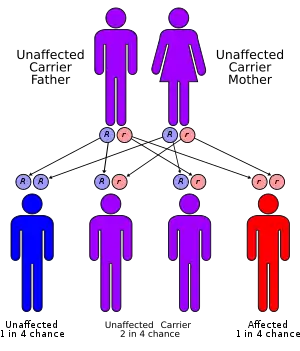Kindler syndrome
Kindler syndrome (also known as "bullous acrokeratotic poikiloderma of Kindler and Weary",[1]) is a rare congenital disease of the skin caused by a mutation in the KIND1 gene.
| Kindler syndrome | |
|---|---|
| Other names | Congenital poikiloderma with blisters and keratoses,[1] Congenital poikiloderma with bullae and progressive cutaneous atrophy,[1] Hereditary acrokeratotic poikiloderma,[1] Hyperkeratosis–hyperpigmentation syndrome,[2]: 511 Acrokeratotic poikiloderma, Weary–Kindler syndrome[3]: 558 |
 | |
| Kindler syndrome has an autosomal recessive pattern of inheritance. | |
| Specialty | Medical genetics, dermatology |
Symptoms and signs
Infants and young children with Kindler syndrome have a tendency to blister with minor trauma and are prone to sunburns. As individuals with Kindler syndrome age, they tend to have fewer problems with blistering and photosensitivity. However, pigment changes and thinning of the skin become more prominent.[4] Kindler syndrome can affect various mucous tissues such as the mouth and eyes, which can lead to other health problems.[5]
Genetics
Kindler syndrome is an autosomal recessive genodermatosis. The KIND1 gene mutated in Kindler syndrome codes for the protein kindlin-1, which is thought to be active in the interactions between actin and the extracellular matrix (focal adhesion plaques).[6] Kindler syndrome was first described in 1954 by Theresa Kindler.[7]
Diagnosis
Clinical and genetic tests are used to confirm diagnosis.[5]
Management
Treatment may involve several different types of practitioner to address the various manifestations that may occur. This multidisciplinary team will also be involved in preventing secondary complications.[8]
References
- Rapini, Ronald P.; Bolognia, Jean L.; Jorizzo, Joseph L. (2007). Dermatology: 2-Volume Set. St. Louis: Mosby. ISBN 978-1-4160-2999-1.
- Freedberg, et al. (2003). Fitzpatrick's Dermatology in General Medicine. (6th ed.). McGraw-Hill. ISBN 0-07-138076-0.
- James, William; Berger, Timothy; Elston, Dirk (2005). Andrews' Diseases of the Skin: Clinical Dermatology. (10th ed.). Saunders. ISBN 0-7216-2921-0.
- Bardhan, Ajoy; Bruckner-Tuderman, Leena; Chapple, Iain L. C.; Fine, Jo-David; Harper, Natasha; Has, Cristina; Magin, Thomas M.; Marinkovich, M. Peter; Marshall, John F.; McGrath, John A.; Mellerio, Jemima E. (2020-09-24). "Epidermolysis bullosa". Nature Reviews Disease Primers. 6 (1): 78. doi:10.1038/s41572-020-0210-0. ISSN 2056-676X. PMID 32973163. S2CID 221861310.
- "Kindler syndrome". Genetics Home Reference. NIH. Retrieved November 18, 2018.
- Siegel DH, Ashton GH, Penagos HG, Lee JV, Feiler HS, Wilhelmsen KC, et al. (July 2003). "Loss of kindlin-1, a human homolog of the Caenorhabditis elegans actin-extracellular-matrix linker protein UNC-112, causes Kindler syndrome". Am. J. Hum. Genet. 73 (1): 174–87. doi:10.1086/376609. PMC 1180579. PMID 12789646.
- Kindler T (March 1954). "Congenital poikiloderma with traumatic bulla formation and progressive cutaneous atrophy". Br. J. Dermatol. 66 (3): 104–11. doi:10.1111/j.1365-2133.1954.tb12598.x. PMID 13149722. S2CID 22888894.
- Adam MP, Ardinger HH, Pagon RA, Wallace SE, Bean LH, Stephens K, Amemiya A, Youssefian L, Vahidnezhad H, Uitto J (December 2016). "Kindler Syndrome - Synonym: Congenital Bullous Poikiloderma". GeneReviews. PMID 26937547.